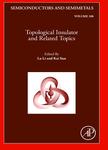版权所有:内蒙古大学图书馆 技术提供:维普资讯• 智图
内蒙古自治区呼和浩特市赛罕区大学西街235号 邮编: 010021

作者机构:Center for High Technology Materials Department of Electrical Computer Engineering University of New Mexico Albuquerque NM United States Center for Materials Science Los Alamos National Laboratory Los Alamos NM United States
出 版 物:《Semiconductors and Semimetals》 (Semicond. Semimet.)
年 卷 期:1993年第38卷第C期
页 面:235-291页
核心收录:
摘 要:This chapter discusses DX and related defects in semiconductors. Often, the most difficult aspect of research into semiconductor defects is arriving at an accurate description of the properties of the defect enabling the study of the defect by any laboratory. While observations of the optical, electrical, and environmental behavior of a defect form a useful starting point, uncertainty over the necessary and sufficient properties for observation and investigation of the defect can linger for a surprisingly long time. Research on the DX center fully reflects these difficulties. Only when the atomic nature and workings of the defect are understood do the interpretations of the defect begin to converge. Such explicit atomic-level understanding has been the goal of recent DX studies, along with attempts at first-principle theories of DX centers. The chapter also discusses the Hall measurements of the electrical properties of semiconductors. A typical Hall measurement consists of a plot of the logarithm of the Hall electron concentration as a function of the inverse temperature 1/ T in kelvins. The slope of such an Arrhenius plot is the standard free enthalpy change of an electron transition from a bound state to the conduction band minimum.